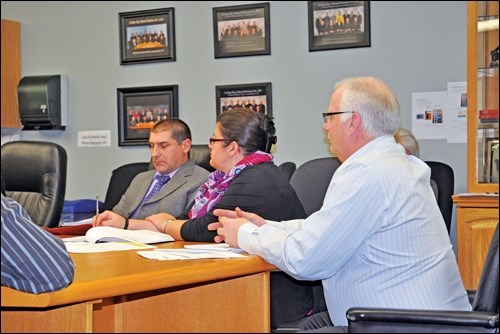While Living Sky School Division has had to add extra routes to accommodate increased student numbers, it continues to find a shortage of people who want to become bus drivers.
Colin Westgard, transportation manager, Wanda leRoux, assistant transportation manager, bus drivers, and Brian Rotsey, assistant transportation manager, fleet, met with the board of education last week with the report on their department’s activities.
Westgard said the human resources department and the transportation department have been working together to look at three of the programs recently presented to the board for the recruitment and retention of bus drivers, an issue faced not only by Living Sky School Division, but school divisions throughout the country.
“We are reviewing costs and implications of a new driver signing bonus, employee referral and substitute bus driver guaranteed minimum wage,” said Westgard.
Each program has merits, he said, but also a cost, some of which would be recovered by not having to pay parents to drive their children to school or have a substitute driver travel from a long distance to cover a route or extracurricular trip.
Division staff have been reaching out to rural communities in a search for new bus drivers. As of last week, they had been to two locations where they talked to people about becoming school bus drivers, said Westgard.
“At one location, we did not receive any applications and at the other one five people indicated that they may be interested,” said Westgard.
They have been following up on the results of the meetings, he said, but they know at least two of the people who expressed interest have decided not to become drivers.
From now until Feb. 12, transportation management is meeting with drivers, casual drivers, principals, vice-principals and secretaries. Twelve communities will be visited and the meetings will serve as a second professional development day for the drivers for the year. Recruitment will be on the agenda, as well as communication, administration, buses, student conduct, weather conditions and extracurricular services. The agenda also allows time for driver concerns.
Among the challenges the transportation department is facing is an increased number of pre-kindergarten students needing bus service for either morning or afternoon pickups or drop off. Where the programming is half day, additional routes have had to be created to bus students either home or to daycare centres at midday.
leRoux noted an additional challenge is the age of the students. When they arrive at school or at daycare, the bus driver cannot leave the bus unattended while the children are getting to and from the venue. From a safety point of view, this is not ideal.
She also said there are occasions when a second person should be on the bus to help, especially when all the students are pre-K age.
Currently, the division has 62 pre-K and daycare students being bussed, up from 25 last year.
While the students are getting younger, bus drivers are getting older. The majority of the division’s drivers are over 40. The largest age group is from 40 to 49 years, however there are several drivers between 65 and 75 years old – and more drivers are looking to retire than to enlist.
The transportation department also reported on the operation of the division’s new bus garage. The bus garage has operated since April 2014 with a staff of one journeyman mechanic, one four-year mechanic and two tradespersons.
With the number of buses and division vehicles being serviced, the garage could use a third journeyman or a four-year mechanic.
“As the division operates 102 to 105 school buses to meet the needs of the regular routes, spares for regular routes and bus service for the extracurricular travel, along with the number of vehicles used by division staff, the number of vehicles to be serviced each day is four,” said Westgard. “To continue to offer the support service in a productive and timely manner, the garage needs to increase its staff by one journeyperson. With this increase one of the tradespeople would be the tow truck operator when needed.”
Having a tow truck owned by the division has become important considering the kind of repairs today’s buses require, Rotsey explained. Many of the breakdowns they experience are related to the electronics system, and there is no “limping” to the garage nowadays; when they break down, they just stop running and need to be towed to service.
The electronics on new buses also mean the equipment needed to diagnose problems is not available in smaller shops.
“It is important to have a division operated garage as some of the local garages either have limited staff or are only interested in doing small jobs. As with all newer vehicles, school buses need to have scanning and other specialty tools that many of the shops would not have,” said the department’s report. “This equipment can be costly and, for a small garage, it would not pay for them to purchase the equipment for the number of buses they have in their community.”
Westgard also pointed out an additional challenge the department faces. There has been an increase in the cost of registration for a school bus from $454 in 2013 to $629 in August of 2014.
“It is costing the division between 35 and 38 per cent more for registration on the buses.”
The board thanked the department for their report and for their ongoing work.
“It always amazes me how you are able to accommodate so many situations in your work,” said board chair Ken Arsenault. “It’s greatly appreciated by staff, parents and students.”




